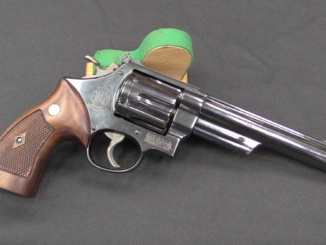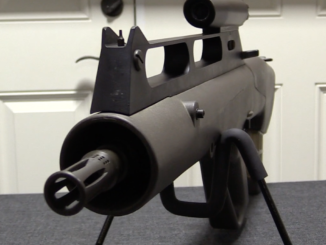When the M14 rifle was developed to replace the M1 Garand, is was met with some uncertainty by the US Navy. The Navy had a lot of things to spend money on, and not a lot of need for a replacement for the M1 Garand (note that the Marine Corps did adopt the M14 despite being a component of the Navy). So instead of buying new rifles, the Navy opted to see if it could just convert its existing M1 rifles to the new 7.62x51mm cartridge.
Because of the similarity between the two cartridges, this seemed to be a fairly simple conversion. A chamber insert was designed which would fill the front of the chamber and allow the use of 7.62x51mm, with the resulting rifle designated the Mark 2 Mod 0. However, the chamber inserts tended to come loose with firing, so a modification was made. grooves were added to the front of the chamber to improve the adherence between insert and chamber. These also tended to come loose, and so the Navy was forced to resort to installing brand new barrels to make their conversions. This was more expensive than they would have liked, but was still much cheaper than buying new M14s, so they went ahead and bought 30,000 new barrels from Springfield Armory in 1965 and 1966. These were installed by H&R and American Machine & Foundry and became designated the Mk2 Mod1 rifles.
The only other modification necessary for the conversion was the addition of a white plastic spacer block in the magazine well. This simply blocked a shooter from inserting a clip of .30-06 cartridges. A .30-06 would not be able to chamber or fire in the new barrels, but the spacer block provided a handy reminder of the rifle’s new chambering. Because these conversions are quite simple, they are fairly easy guns to fake. This particular example includes sales paperwork from the CMP confirming its originality.




Sailors tend not to get into infantry fights so why bother getting new rifles when the old ones are good enough for sentry duty on shore? I see that training doesn’t change much with the conversion. What idiot raids a navy port with only a pistol and nothing else anyhow?
At the time it was at least theoretically possible for sailors to deploy as infantry in a Naval Landing Party, if an emergency broke out and not enough Marines were available. I have in my collection a Navy manual dated 1960 that specified how it was to be done.
Seem to recall the Navy, well US Navy anyway, had M14s by the time the early 80s rolled around. Pistols were .45. All were pretty well worn. No mention, to say nothing of any sightings, of the M1, 30-06 or 7.62Nato.
But 30K rifles is not that many for a whole service. Might have been a pretty limited issue to one fleet (Atlantic, Med or Pacific)? Or maybe replaced fairly soon after in the 1970s?
As I stated in another post, my ship’s armory had M-1’s in the early 70’s and I seem to recall they were in 30-06 chambering. My personal M-1 is a conversion with NM treatment and missing the magazine block.
I cannot see any advantage to this conversion. It offers no tactical advantage.
However there are disadvantages:
1) It adds another item to the inventory system, 7.62 ammo in M1 clips
2) two identical rifles in two different calibres inviting an issue mix up of 30 cal and 7.62
You no what they say: amateurs think about tactics, professionals think about logistics… Since the USMC was already adopting the M14 chambered in 7.62 NATO, it made good logistical sense for the USN to convert their rifles to the same cartridge.
You obviously didn’t serve in the Navy like I did (’69-’75) or you would know that the Marines belonged to the Navy as Naval Infantry. I qualified in Navy boot camp with one of the sleeve-insert converted M1’s (“expert”, BTW). Never fired an M16 for another 5 years. Besides the change in weight between the 7.62 M1 wood-stocked enbloc or M1A magazine-fed (even heavier with fully-loaded magazine) & the M16 5.56 magazine-fed rifles, minor though it might be, when multiplied by 42 bazillion it does makes a difference in shipping & carrying weight logistics, being that 2 M16 cartridges take up about the same weight/volume as one 7.62 cartridge & the M16 rifle is short & lighter than the M1A. There really wasn’t much of a change in accuracy when the rifles are fired at the same rate of fire, although the “spray & pray” of the M16 “full-auto” mode option didn’t really help unless firing in a close-range “target rich” environment. Did I mention I was a supply specialist (“Quartermaster”) and rangemaster armorer/repair tech in the the Army & civilian life?
I think it’s safe to assume that the two rifles were not fielded together. That is, ships or bases with .30-06 M1’s replaced all of them at one time, not one rifle at a time. The older rifles and ammo were probably kept in reserve for some time, though.
I keep a 7.62 NATO chamber sleeve (along with a broken case extractor to remove it) in the buttstock of my .30-06 Ruger M-77. Chamber sleeves can come lose in semi-auto guns during rapid firing but not bolt actions.
I might add, you can still find companies that sell them online. To install, just slip it over a .308 and it will be fire-formed into the chamber and stay put. To remove it, insert a broken case extractor and tap it out with a cleaning rod. The sleeve can be reused over and over.
The advantage is that 7.62 NATO ball is cheaper than .30-06 for target shooting but you can switch back to .30-06 for hunting.
It is perhaps worth noting that they didn’t change the sights: the difference in drop of a 7.62×51 vs .30-06 are less than a few inches out to well over 500 yards so I guess they felt it didn’t matter. I wonder if the match shooters did anything with the sights though, because (for example) 3 inches at 500 yards would likely matter to them.
Why not just leave them as-was and restrict Garands and 30-06 to the Navy until they wore/ran out?
Logistics, plain and simple. When the guys at the top demand conformity to a standard, they will never take a “no” response seriously. By this point in the Cold War, nonstandard cartridges were seen as a potential failure point. Remember what doomed the Japanese Empire the most? A ludicrously complex logistics system with inter service backstabbing and four different rifle cartridge types to supply at minimum! Who’s going to supply the older cartridges for the Navy if everyone else buys the new stuff? “Make everything use the same ammunition and we’ll have fewer headaches!!”
“Remember what doomed the Japanese Empire the most? A ludicrously complex logistics system with inter service backstabbing and four different rifle cartridge types to supply at minimum!”
Well, I would say if Army would have single own rifle cartridge and Navy also single own rifle cartridge, each different from other this would not be great problem – problem started with each branch having de facto less-or-more redundant cartridges in own systems.
So if the Imperial Japanese Army had stuck with 7.7×58 and the Imperial Japanese Navy chosen something else like 8×57 IS, would that satisfy your requirements?
Yes. Notice that in most cases Navy and Army already have own supply chains.
Also because the machinery that used to produce .30-06 ammo in the US Arsenal system was converted to make 7.62mm NATO.
.30-’06 clips worked with 7.62 NATO with no alteration?
“.30-’06 clips worked with 7.62 NATO with no alteration”
I see no reason which would prevent putting 7.62 NATO in such clips:
https://en.wikipedia.org/wiki/File:Garand_clip.jpg
its length is less than half of .30-06 Springfield cartridge
“Its length is less than 1/2 of 30-06” Absolutely not true. OAL of 30-06 is 3.38 inches–OAL of 7.62 is 2.8 inches, both of course pluse thickness of 8 red enbloc clip. Simply NOT less than half.
I mean length of clip: in other words: when .30-06 cartridge is put into clip more than half of it protrude.
Fulton Armory in Maryland will convert your Garand for you (with no attempt to deceive the collectors market), so you can have your own if you’d like. If you are shooting 150 FMJ, 30’06 offers no advantage over 308 and 308 has some advantages (less powder, cheaper and more plentiful ammo)
For what it is worth, the US Navy eventually went with the M14–and still has it inventory. Perhaps having a mix of M14’s and converted M1’s in inventory at the same time was made easier with a common cartridge?
Other than holding more cartridges, what is the advantage of the M14 over the M1? The M14 is overly-long and awkward with that super-long flash hider and (in my completely subjective opinion) recoils harder in .308 than the M1 in .30-06. Otherwise, same triggers and sights.
Some people have wondered why not just use up the existing .30-06 ammo? A lot of that, along with Army and Marine rifles, was being given away to countries that needed to rebuild their armies after WWII and/or were fighting civil wars. Fast forward decades later and some of those rifles were obsoleted by those countries and found their way back to the US civilian market via the DCM/CMP programs.
The companies selling after-market barrels for the M1 Garand tend to make them in both .308 and .30-06, so it is up to the person paying for the new barrel as to which cartridge to go with. Any gunsmith that can replace an M1 barrel can install one or the other. Shuff’s Parkerizing (do a web search) will even do a conversion to accept M14 magazines, similar to what the Italians did with the BM59.
“At the time it was at least theoretically possible for sailors to deploy as infantry in a Naval Landing Party, if an emergency broke out and not enough Marines were available. I have in my collection a Navy manual dated 1960 that specified how it was to be done.”
My father participated in perhaps one of the last landing parties in US Navy history. In the occupation of Japan, speed was thought to be of the essence, so the big ships’ marine detachments were sent ashore but needed to be reinforced by sailors. My dad was aboard a light carrier (CVL) and responded when the word was put out for volunteers. By the way, although his ship’s leathernecks carried M1’s by 1945, he and the other sailors were issued Springfields. I don’t know if they were M1903’s or M1903A3’s. Dad came back with a souvenir as he traded a pack of smokes for a silver one yen (we think) coin about the size of a US silver dollar. The Japanese civilians originally all turned their backs to the Americans as a mark of respect, afraid of offending by daring to view their conquerors.
https://external-preview.redd.it/dYbbBm3eLJQPS87UyrCupCDWK4otCMkuzrKXaR4vhmk.jpg?auto=webp&s=55834357926c236728b6666099dddcb076a39e41
https://laststandonzombieisland.com/2012/04/10/us-naval-landing-parties/
Also, when I was in Army ROTC 1970-74, the Naval ROTC midshipmen were still drilling with M1’s. I don’t know if they (the rifles, not the Middies) were converted or not.
Last, one reason the M14 hung around in the Navy was its use to fire lines from ship to ship for underway replenishment.
I have heard that back turning debated. There are those who say the gesture signals more fear and loathing than respect. Having seen how U.S. servicemen behave abroad, that explanation takes on some cogency